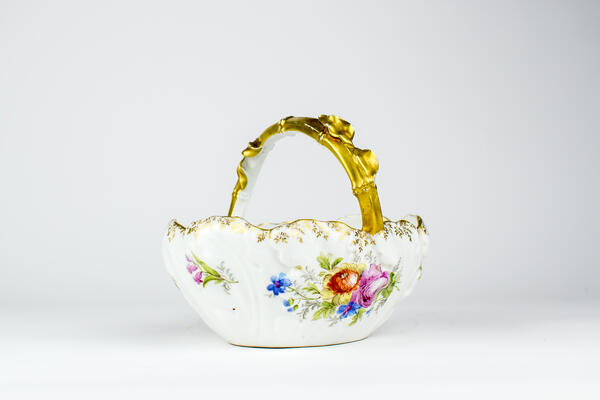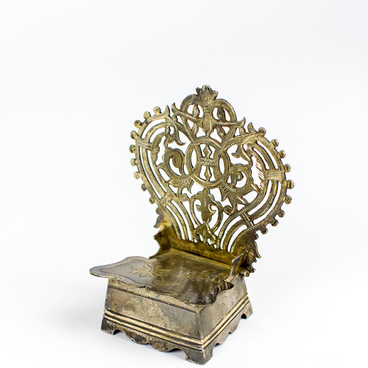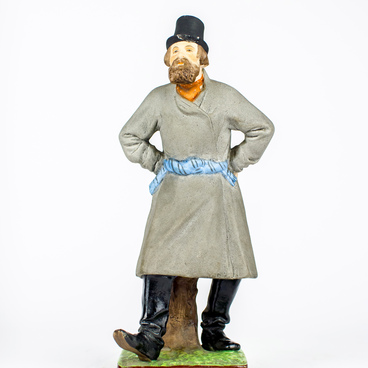The white relief porcelain crouton basket with flowers on the sides was made in the shape of a basket with a gilded decorative handle. Along the edge the bowl is decorated with a gilded twigs ornament. At its bottom, the stamp of the French porcelain factory from the city of Limoges, R. Delinieres & Co has been preserved.
For a long time, porcelain products were imported to France from China. Chinese porcelain was very expensive and considered luxury. A great amount of silver was sent from Europe to China as payment for the products.
European craftsmen tried to make porcelain on their own. White earthenware in the Chinese style, with blue decor, was first made in France at the manufactories of Nevers in Burgundy. It was produced from 1650 to 1680. Then the production of porcelain itself, thinner and more transparent than earthenware, in the Chinese style, began at the factories of Normandy.
The first samples of soft fritted (sintered) porcelain in France were made back in 1673 in Normandy at the Rouen Porcelain Manufactory as a result of a series of attempts to imitate real Chinese porcelain. It was this porcelain that became known as French porcelain. The Rouen potter Louis Potter discovered the technology for making the new material. His license for the manufacture of earthenware and porcelain was signed in 1673 by King Louis the 14th and the head of government, Jean-Baptiste Colbert. The English naturalist Martin Lister, in his account of a trip to France published in 1698 wrote from Paris that the production of porcelain “as white and translucent as items that came from the East” was established in the French town of Saint-Cloud.
In the 17th century, many small manufactories, which later became famous factories, appeared in France. Limoges porcelain, for example, is the name of the ceramics which were produced in the French town of Limoges around 1770, immediately after the discovery of deposits of kaolin clay in this area. Legend has it that one pharmacist in Limoges always admired the whiteness of his colleague’s shirts. He said that they were so dazzlingly white thanks to the use of a special clay, which his wife generously added when washing. The industrialists who discovered the kaolin deposit soon found out about this story.
For a long time, porcelain products were imported to France from China. Chinese porcelain was very expensive and considered luxury. A great amount of silver was sent from Europe to China as payment for the products.
European craftsmen tried to make porcelain on their own. White earthenware in the Chinese style, with blue decor, was first made in France at the manufactories of Nevers in Burgundy. It was produced from 1650 to 1680. Then the production of porcelain itself, thinner and more transparent than earthenware, in the Chinese style, began at the factories of Normandy.
The first samples of soft fritted (sintered) porcelain in France were made back in 1673 in Normandy at the Rouen Porcelain Manufactory as a result of a series of attempts to imitate real Chinese porcelain. It was this porcelain that became known as French porcelain. The Rouen potter Louis Potter discovered the technology for making the new material. His license for the manufacture of earthenware and porcelain was signed in 1673 by King Louis the 14th and the head of government, Jean-Baptiste Colbert. The English naturalist Martin Lister, in his account of a trip to France published in 1698 wrote from Paris that the production of porcelain “as white and translucent as items that came from the East” was established in the French town of Saint-Cloud.
In the 17th century, many small manufactories, which later became famous factories, appeared in France. Limoges porcelain, for example, is the name of the ceramics which were produced in the French town of Limoges around 1770, immediately after the discovery of deposits of kaolin clay in this area. Legend has it that one pharmacist in Limoges always admired the whiteness of his colleague’s shirts. He said that they were so dazzlingly white thanks to the use of a special clay, which his wife generously added when washing. The industrialists who discovered the kaolin deposit soon found out about this story.



